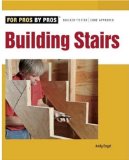 In the last post in this series, I explained the different terms associated with building stairs. In today’s post, I’ll show you how to get the measurements necessary to layout the stringers that will support our stairs.
In the last post in this series, I explained the different terms associated with building stairs. In today’s post, I’ll show you how to get the measurements necessary to layout the stringers that will support our stairs.
The first measurement we need is the rise. As you recall from our last post, the rise is the vertical distance from the top of our deck to the ground. To get the rise, we take a tape measure and measure the height from the ground to the top of the deck or landing the stairs will attach to. Let’s say for example our deck is 42-3/4″ high. In order to get the run measurement, which is the horizontal distance our stairs will protrude from the deck, we first need to divide 42.75 by 7.25 using a calculator.
The result is 5.9. The number 5.9 represents the number of risers our set of stairs will need to reach the ground. Since we can’t have part of a riser, we’ll round up to 6 risers. Now to get the run, we subtract 1 from 6 because the number of treads is always 1 less than the number of risers and we multiply 5 times 10.5 and this equals 52.5 or 52-1/2″, which is the horizontal distance our stairs will extend out from the deck.
I know you’re wondering where the numbers 7.25 and 10.5 came from. The International Building Code stipulates that stairs should be built with a 7″ rise and an 11″ tread. These distances make for the most comfortable stride when ascending or descending stairs. Stairs must also be constructed with risers that are equal in distance. Stairs with different riser heights on the same stair will cause a person to fall because of the inconsistency.
Now to determine the exact riser height for our stair design, we need to divide 42.75, our rise, by 6, the number of risers, and the result of this operation will be 7.125 or 7-1/8″ for our riser measurement.
Now we need a framing square, which is the large metal square that is long on one side and shorter on the other. We’ll take some masking tape and wrap it around the framing square on the short side right on the 7-1/8″ mark along the outside of the square.
Now we need to wrap some masking tape around the long side of the square at the 10-1/2″ mark on the outside of the square. These two pieces of tape will serve as our markers for laying out the stringer. The next step is to layout the cuts on the 2″ x 10″ board our stringer will be cut from using the masking tape as a guide. Note that the bottom riser must be shorter than the other risers by the thickness of the board you’ll be using for the stair treads. If you don’t make this allowance, the bottom riser will be higher than the others when you add the strair tread to the stairs. This could cause someone to fall because of the inconsistent height of the last riser.
When the stringer is laid out, cut to the inside of the V with your circular saw and then finish the cut with a saber saw or hand saw. The illustration above shows 8 treads but remember we only need 5 so we’ll be cutting our stringer off at the end of the 5th tread.
Now that you have one stringer cut, use it for a pattern for the other stringers. If the stairs are 36″ wide or less, you will only need two stringers. If the stairs are more than 36″ wide, you will need three or more depending on the width of the stairs.
The last part that we’ll be cutting in this post is the support braces that connect the stringers together. These will be cut from two 2″ x 6″ boards that will be 10″ shorter than the width of your stairs. In other words, if you want your stair tread to be 36″ wide, these braces will be 26″ long because they will fit between the two stringers. This will allow 3-1/2″ overhang on each side to accomodate the 4 x 4 posts on each side of the stairs of the deck.
If you need more information about building stairs, I recommend this book entitled Building Stairs. In our next post, I’ll be talking about assembling the stairs from the parts we’ve cut out. Until next time, stay safe, work hard, and as always, thanks for stopping by MVB Crafts.
Regards,

P.S.
If this series of posts about Building Stairs has help you but you would like more information, click here and buy the book. By clicking the link from this site, I’ll get a commision on the sale and you’ll get some great information.
Thanks.


